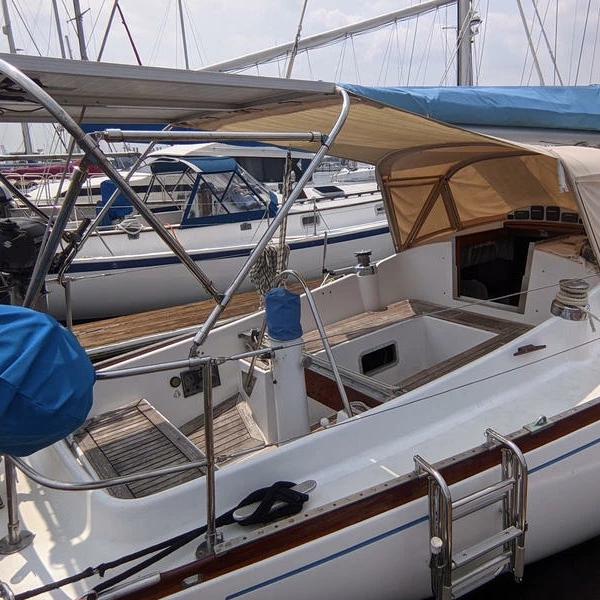Seller's Description
For sale is our Nautor Swan 40, with all the cruising options needed whether to live comfortably onboard or just for weekend sails. True turnkey yacht, setup for easy single handed sailing, with working Aries Windvane. We have been cruising the Pacific and Caribbean for the past few years and maintained this yacht very diligently. Appreciate the strong build of an older boat coupled with reliable technology of todays standards. Active online community of those beautiful, classic yachts of Sparkman & Stephens at classicswan dot org.
Hard dinghy with 2.5 hp outboard. Recent antifouling and seacock/thruhull serviced in March 2023. No blisters.
Equipment: New Lifepo4 batteries 2023 New king size mattress in v-berth 2020 New AIS wifi Transceiver in 2019 New comfort seat cushions in 2020 New main and genoa sails in 2019 New 200 Watt solar panels 2018 New Ray marine autopilot 2017 New cutless bearing 2019 New dripless shaft seal 2016 New shaft and coupling 2016 Mast unstepped, rigging inspected/replaced, mast step inspected/serviced, new cabling 2016
Specs
- Designer
- Sparkman & Stephens
- Builder
- Nautor (Swan sailboats)
- Associations
- ?
- # Built
- 51
- Hull
- Monohull
- Keel
- Fin
- Rudder
- Skeg
- Construction
- FG
Dimensions
- Length Overall
- 39′ 11″ / 12.2 m
- Waterline Length
- 28′ 6″ / 8.7 m
- Beam
- 10′ 11″ / 3.4 m
- Draft
- 6′ 5″ / 2 m
- Displacement
- 19,000 lb / 8,618 kg
- Ballast
- 7,900 lb / 3,583 kg (Lead)
Rig and Sails
- Type
- Sloop
- Reported Sail Area
- 709′² / 65.9 m²
- Total Sail Area
- 709′² / 65.8 m²
Mainsail
- Sail Area
- 320′² / 29.7 m²
- P
- 44′ 0″ / 13.4 m
- E
- 14′ 6″ / 4.4 m
- Air Draft
- ?
Foresail
- Sail Area
- 388′² / 36.1 m²
- I
- 49′ 0″ / 15 m
- J
- 15′ 10″ / 4.8 m
- Forestay Length
- 51′ 6″ / 15.7 m
Auxilary Power
- Make
- Volvo Penta
- Model
- MD2B
- HP
- 25
- Fuel Type
- Diesel
- Fuel Capacity
- 40 gal / 151 l
- Engine Hours
- ?
Accomodations
- Water Capacity
- 48 gal / 182 l
- Holding Tank Capacity
- ?
- Headroom
- ?
- Cabins
- 2
Calculations
- Hull Speed
-
7.1 kn
Classic: 7.16 kn
Hull Speed
The theoretical maximum speed that a displacement hull can move efficiently through the water is determined by it's waterline length and displacement. It may be unable to reach this speed if the boat is underpowered or heavily loaded, though it may exceed this speed given enough power. Read more.
Formula
Classic hull speed formula:
Hull Speed = 1.34 x √LWL
A more accurate formula devised by Dave Gerr in The Propeller Handbook replaces the Speed/Length ratio constant of 1.34 with a calculation based on the Displacement/Length ratio.
Max Speed/Length ratio = 8.26 ÷ Displacement/Length ratio.311
Hull Speed = Max Speed/Length ratio x √LWL
- Sail Area/Displacement
-
15.9
<16: under powered
Sail Area / Displacement Ratio
A measure of the power of the sails relative to the weight of the boat. The higher the number, the higher the performance, but the harder the boat will be to handle. This ratio is a "non-dimensional" value that facilitates comparisons between boats of different types and sizes. Read more.
Formula
SA/D = SA ÷ (D ÷ 64)2/3
- SA: Sail area in square feet, derived by adding the mainsail area to 100% of the foretriangle area (the lateral area above the deck between the mast and the forestay).
- D: Displacement in pounds.
- Ballast/Displacement
-
41.6
>40: stiffer, more powerful
Ballast / Displacement Ratio
A measure of the stability of a boat's hull that suggests how well a monohull will stand up to its sails. The ballast displacement ratio indicates how much of the weight of a boat is placed for maximum stability against capsizing and is an indicator of stiffness and resistance to capsize.
Formula
Ballast / Displacement * 100
- Displacement/Length
-
364.7
300-400: heavy
Displacement / Length Ratio
A measure of the weight of the boat relative to it's length at the waterline. The higher a boat’s D/L ratio, the more easily it will carry a load and the more comfortable its motion will be. The lower a boat's ratio is, the less power it takes to drive the boat to its nominal hull speed or beyond. Read more.
Formula
D/L = (D ÷ 2240) ÷ (0.01 x LWL)³
- D: Displacement of the boat in pounds.
- LWL: Waterline length in feet
- Comfort Ratio
-
38.4
30-40: moderate bluewater cruising boat
Comfort Ratio
This ratio assess how quickly and abruptly a boat’s hull reacts to waves in a significant seaway, these being the elements of a boat’s motion most likely to cause seasickness. Read more.
Formula
Comfort ratio = D ÷ (.65 x (.7 LWL + .3 LOA) x Beam1.33)
- D: Displacement of the boat in pounds
- LWL: Waterline length in feet
- LOA: Length overall in feet
- Beam: Width of boat at the widest point in feet
- Capsize Screening
-
1.6
<2.0: better suited for ocean passages
Capsize Screening Formula
This formula attempts to indicate whether a given boat might be too wide and light to readily right itself after being overturned in extreme conditions. Read more.
Formula
CSV = Beam ÷ ³√(D / 64)
- Beam: Width of boat at the widest point in feet
- D: Displacement of the boat in pounds
Notes
S&S design #2025. A centerboard version was also available. (S&S #2025.1)
Available also with a taller rig.
Also available in the US as the PALMER JOHNSON 40.
This listing is presented by SailboatListings.com. Visit their website for more information or to contact the seller.













